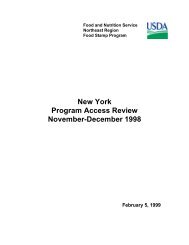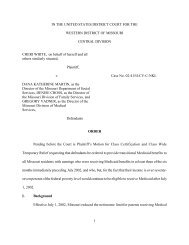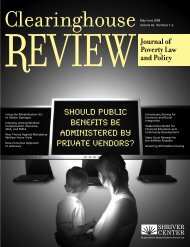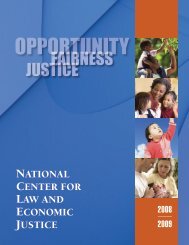The Role of the Courts in Securing Welfare Rights and ...
The Role of the Courts in Securing Welfare Rights and ...
The Role of the Courts in Securing Welfare Rights and ...
You also want an ePaper? Increase the reach of your titles
YUMPU automatically turns print PDFs into web optimized ePapers that Google loves.
<strong>Welfare</strong> Law Centereligible under federal st<strong>and</strong>ards. 4 Federal regulations were used successfully <strong>in</strong> many cases toattack abusive eligibility verification practices <strong>and</strong> excessive applications process delays. 5 Needyfamilies could br<strong>in</strong>g court cases based on federal AFDC law because <strong>the</strong> federal statute, 42 U.S.C.602 (a)(10), gave <strong>in</strong>dividuals an entitlement to aid <strong>and</strong> provided <strong>the</strong> federal match<strong>in</strong>g funds toback up that entitlement. Of course, because <strong>the</strong> former AFDC program was a federal-stateprogram, states also had <strong>the</strong>ir own welfare statutes. However, litigation typically focused onenforc<strong>in</strong>g federal requirements, ra<strong>the</strong>r than state law. 6 Generally federal courts were considered afriendlier forum than state courts, <strong>and</strong> <strong>the</strong>re was a body <strong>of</strong> uniform federal law on whichadvocates could rely.<strong>The</strong> federal law establish<strong>in</strong>g TANF, <strong>the</strong> block grant program that replaced AFDC,elim<strong>in</strong>ates <strong>the</strong> federal guarantee <strong>of</strong> aid to <strong>in</strong>dividuals. 7 <strong>The</strong> federal law also gives states broaddiscretion to design welfare programs <strong>and</strong> at <strong>the</strong> same time limits that discretion <strong>in</strong> key areas,notably by requir<strong>in</strong>g time limits on an <strong>in</strong>dividual’s receipt <strong>of</strong> federal aid <strong>and</strong> impos<strong>in</strong>g strict workrequirements.In light <strong>of</strong> <strong>the</strong>se changes <strong>in</strong> federal welfare law, a family’s rights to welfare benefits arenow def<strong>in</strong>ed under state law <strong>and</strong> <strong>in</strong>dividuals must look primarily to <strong>the</strong>se state welfare laws,which vary from state to state, to determ<strong>in</strong>e <strong>the</strong> extent <strong>of</strong> <strong>the</strong>ir rights. In addition, <strong>in</strong> some stateswhich have delegated decisionmak<strong>in</strong>g to localities, <strong>the</strong>re may not even be state law to enforce.Advocates may have to explore local law.<strong>The</strong>re has not yet been extensive litigation seek<strong>in</strong>g to enforce state TANF laws, but <strong>the</strong>litigation to date has primarily <strong>in</strong>volved work program requirements <strong>and</strong> <strong>the</strong> fair hear<strong>in</strong>gs system(as to <strong>the</strong> latter see also <strong>the</strong> due process discussion, below). Examples <strong>of</strong> recent litigationenforc<strong>in</strong>g state welfare laws (under both TANF <strong>and</strong> <strong>the</strong> former AFDC program) <strong>in</strong>clude <strong>the</strong>follow<strong>in</strong>g:TANF Litigation:Davila v. Hammons (New York). 8 This case is based on state welfare law <strong>and</strong> challengesNew York City’s practice <strong>of</strong> assign<strong>in</strong>g recipients to unpaid workfare without do<strong>in</strong>g an <strong>in</strong>dividualMay 1999⋅ 6 ⋅








